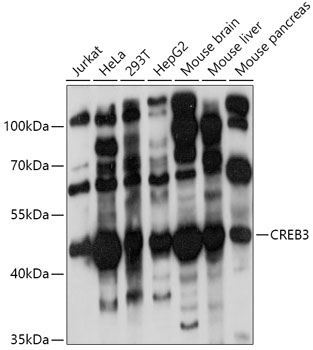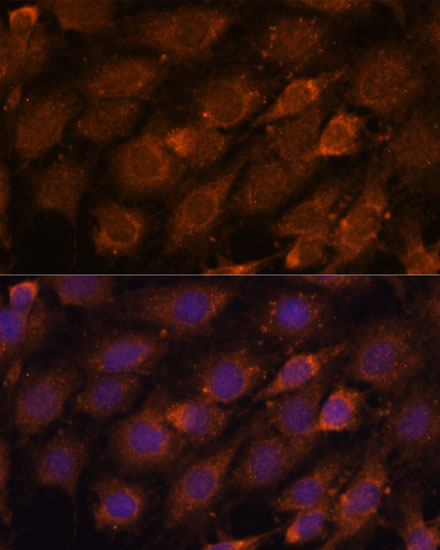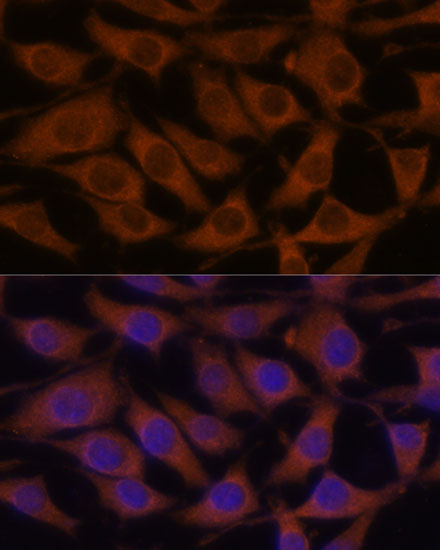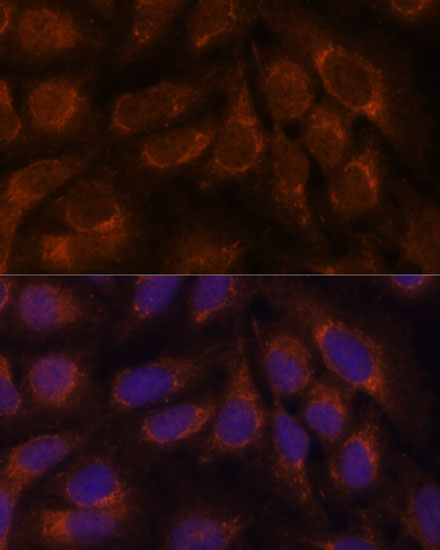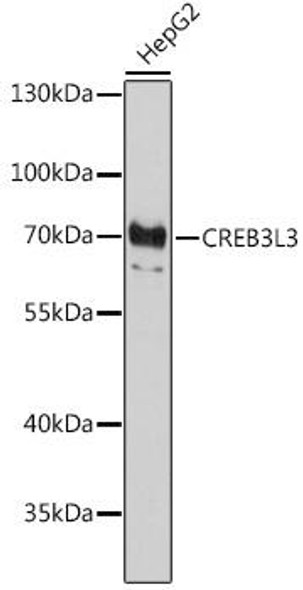Anti-CREB3 Antibody (CAB6567)
- SKU:
- CAB6567
- Product type:
- Antibody
- Reactivity:
- Human
- Mouse
- Rat
- Host Species:
- Rabbit
- Isotype:
- IgG
- Antibody Type:
- Polyclonal Antibody
- Research Area:
- Cell Biology
Description
| Antibody Name: | Anti-CREB3 Antibody |
| Antibody SKU: | CAB6567 |
| Antibody Size: | 20uL, 50uL, 100uL |
| Application: | WB IF |
| Reactivity: | Human, Mouse, Rat |
| Host Species: | Rabbit |
| Immunogen: | Recombinant fusion protein containing a sequence corresponding to amino acids 1-230 of human CREB3 (NP_006359.3). |
| Application: | WB IF |
| Recommended Dilution: | WB 1:500 - 1:2000 IF 1:10 - 1:100 |
| Reactivity: | Human, Mouse, Rat |
| Positive Samples: | Jurkat, HeLa, 293T, HepG2, Mouse brain, Mouse liver, Mouse pancreas |
| Immunogen: | Recombinant fusion protein containing a sequence corresponding to amino acids 1-230 of human CREB3 (NP_006359.3). |
| Purification Method: | Affinity purification |
| Storage Buffer: | Store at -20°C. Avoid freeze / thaw cycles. Buffer: PBS with 0.02% sodium azide, 50% glycerol, pH7.3. |
| Isotype: | IgG |
| Sequence: | MELE LDAG DQDL LAFL LEES GDLG TAPD EAVR APLD WALP LSEV PSDW EVDD LLCS LLSP PASL NILS SSNP CLVH HDHT YSLP RETV SMDL ESES CRKE GTQM TPQH MEEL AEQE IARL VLTD EEKS LLEK EGLI LPET LPLT KTEE QILK RVRR KIRN KRSA QESR RKKK VYVG GLES RVLK YTAQ NMEL QNKV QLLE EQNL SLLD QLRK LQAM VIEI SNKT SSSS TC |
| Gene ID: | 10488 |
| Uniprot: | O43889 |
| Cellular Location: | Cytoplasm, Endoplasmic reticulum membrane, Membrane, Nucleus, Single-pass type II membrane protein |
| Calculated MW: | 39kDa/41kDa/43kDa |
| Observed MW: | 41kDa |
| Synonyms: | CREB3, LUMAN, LZIP, sLZIP |
| Background: | This gene encodes a transcription factor that is a member of the leucine zipper family of DNA binding proteins. This protein binds to the cAMP-response element and regulates cell proliferation. The protein interacts with host cell factor C1, which also associates with the herpes simplex virus (HSV) protein VP16 that induces transcription of HSV immediate-early genes. This protein and VP16 both bind to the same site on host cell factor C1. It is thought that the interaction between this protein and host cell factor C1 plays a role in the establishment of latency during HSV infection. This protein also plays a role in leukocyte migration, tumor suppression, and endoplasmic reticulum stress-associated protein degradation. Additional transcript variants have been identified, but their biological validity has not been determined. |
| UniProt Protein Function: | CREB3: Endoplasmic reticulum (ER)-bound transcription factor that plays a role in the unfolded protein response (UPR). Involved in cell proliferation and migration, tumor suppression and inflammatory gene expression. Plays also a role in the human immunodeficiency virus type 1 (HIV-1) virus protein expression and in the herpes simplex virus-1 (HSV-1) latent infection and reactivation from latency. Isoform 2 plays a role in the unfolded protein response (UPR). Isoform 2 acts as a positive regulator of LKN-1/CCL15-induced chemotaxis signaling of leukocyte cell migration. Isoform 2 may play a role as a cellular tumor suppressor that is targeted by the hepatitis C virus (HSV) core protein. Isoform 2 represses the VP16-mediated transactivation of immediate early genes of the HSV-1 virus by sequestring host cell factor-1 HCFC1 in the ER membrane of sensory neurons, thereby preventing the initiation of the replicative cascade leading to latent infection. Isoform 3 functions as a negative transcriptional regulator in ligand-induced transcriptional activation of the glucocorticoid receptor NR3C1 by recruiting and activating histone deacetylases (HDAC1, HDAC2 and HDAC6). Isoform 3 decreases the acetylation level of histone H4. Isoform 3 does not promote the chemotactic activity of leukocyte cells. Belongs to the bZIP family. ATF subfamily. 3 isoforms of the human protein are produced by alternative splicing. |
| UniProt Protein Details: | Protein type:Membrane protein, integral; Transcription factor Chromosomal Location of Human Ortholog: 9p13.3 Cellular Component: Golgi membrane; nuclear body; Golgi apparatus; endoplasmic reticulum membrane; cell soma; membrane; endoplasmic reticulum; cytoplasm; integral to membrane; integral to endoplasmic reticulum membrane; cytosol; nucleus Molecular Function:protein dimerization activity; CCR1 chemokine receptor binding; protein binding; protein homodimerization activity; DNA binding; cAMP response element binding protein binding; chromatin binding; transcription factor activity Biological Process: transcription from RNA polymerase II promoter; cytoplasmic sequestering of transcription factor; transcription, DNA-dependent; viral reproduction; positive regulation of transcription, DNA-dependent; positive regulation of transcription of target genes involved in unfolded protein response; establishment of viral latency; chemotaxis; negative regulation of cell cycle; regulation of cell proliferation; induction of positive chemotaxis; reactivation of latent virus; positive regulation of transcription from RNA polymerase II promoter; regulation of cell growth; positive regulation of calcium ion transport; positive regulation of defense response to virus by host; positive regulation of cell migration |
| NCBI Summary: | This gene encodes a transcription factor that is a member of the leucine zipper family of DNA binding proteins. This protein binds to the cAMP-response element and regulates cell proliferation. The protein interacts with host cell factor C1, which also associates with the herpes simplex virus (HSV) protein VP16 that induces transcription of HSV immediate-early genes. This protein and VP16 both bind to the same site on host cell factor C1. It is thought that the interaction between this protein and host cell factor C1 plays a role in the establishment of latency during HSV infection. This protein also plays a role in leukocyte migration, tumor suppression, and endoplasmic reticulum stress-associated protein degradation. Additional transcript variants have been identified, but their biological validity has not been determined.[provided by RefSeq, Nov 2009] |
| UniProt Code: | O43889 |
| NCBI GenInfo Identifier: | 55583791 |
| NCBI Gene ID: | 10488 |
| NCBI Accession: | O43889.1 |
| UniProt Secondary Accession: | O43889,O14671, O14919, Q5TCV1, Q96GK8, Q9H2W3, Q9UE77 D0PTW6, |
| UniProt Related Accession: | O43889 |
| Molecular Weight: | 395 |
| NCBI Full Name: | Cyclic AMP-responsive element-binding protein 3 |
| NCBI Synonym Full Names: | cAMP responsive element binding protein 3 |
| NCBI Official Symbol: | CREB3 |
| NCBI Official Synonym Symbols: | LZIP; LUMAN; sLZIP |
| NCBI Protein Information: | cyclic AMP-responsive element-binding protein 3; CREB-3; leucin zipper proitein; leucine zipper protein; basic leucine zipper protein; small leucine zipper protein; transcription factor LZIP-alpha; cAMP-responsive element-binding protein 3; cyclic AMP response element (CRE)-binding protein/activating transcription factor 1 |
| UniProt Protein Name: | Cyclic AMP-responsive element-binding protein 3 |
| UniProt Synonym Protein Names: | Leucine zipper protein; Luman; Transcription factor LZIP-alphaProcessed cyclic AMP-responsive element-binding protein 3; N-terminal Luman; Transcriptionally active form |
| Protein Family: | CREB3 regulatory factor |
| UniProt Gene Name: | CREB3 |
| UniProt Entry Name: | CREB3_HUMAN |


